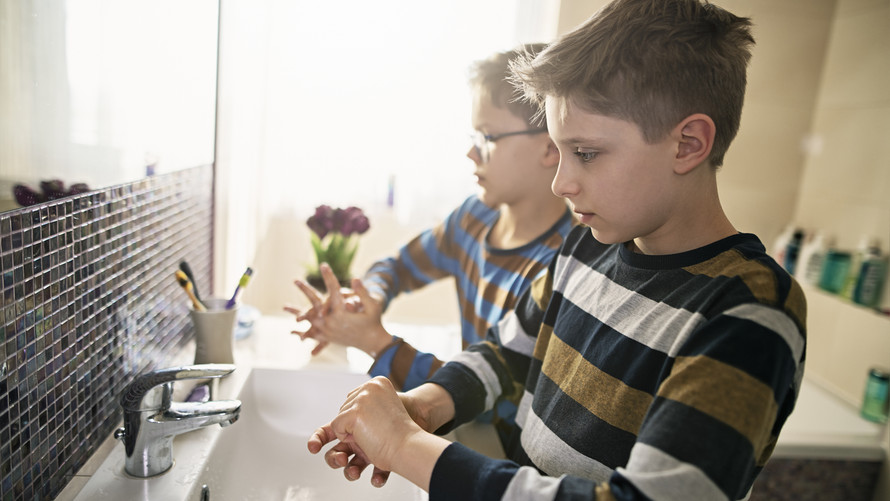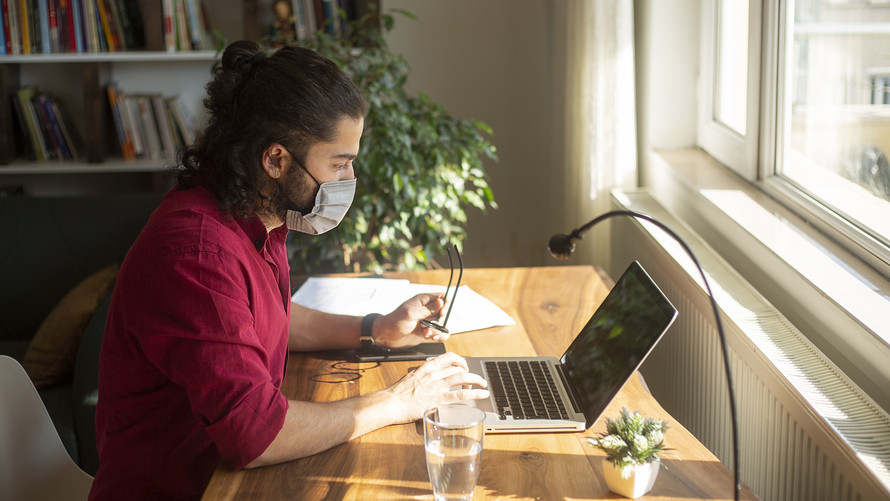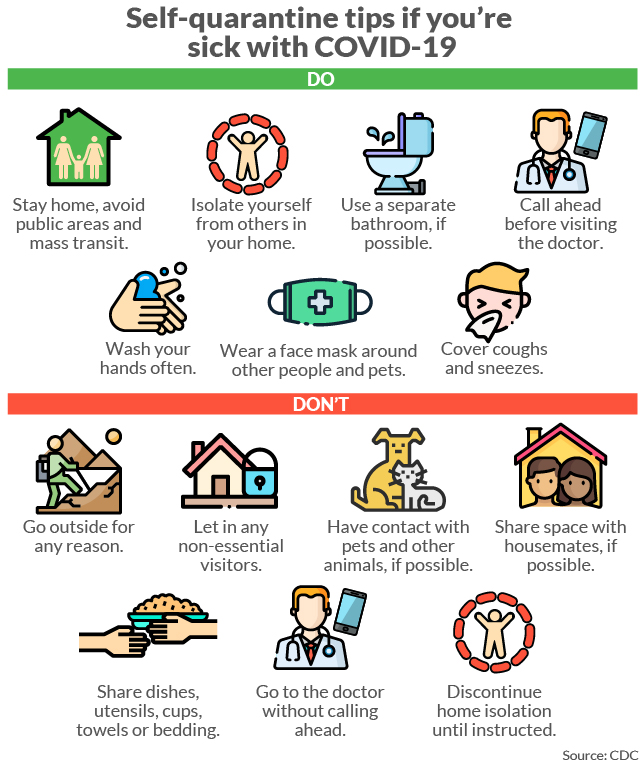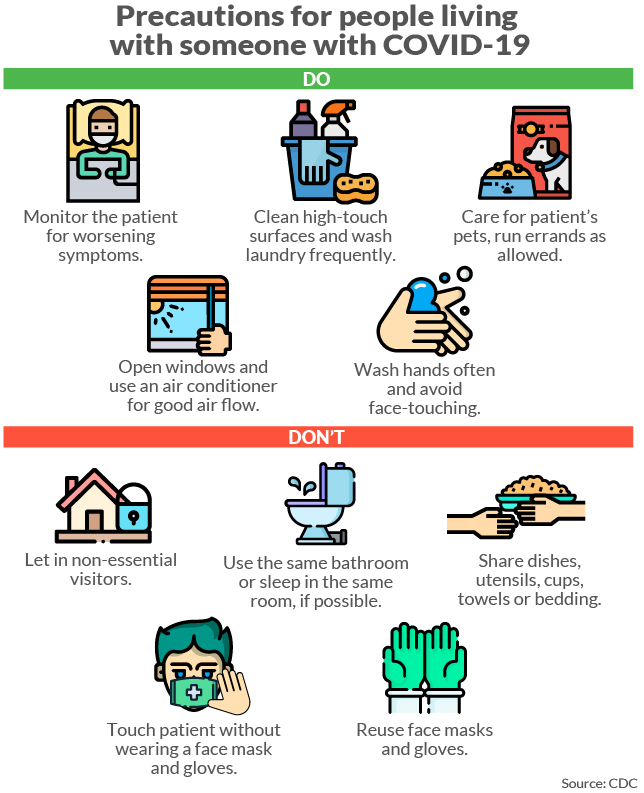Thousands of Americans have been asked to self-quarantine or to self-monitor over coronavirus fears, including CNN anchor Chris Cuomo, brother of New York Gov. Andrew Cuomo, who revealed Tuesday that he will continue broadcasting his show from isolation.
Lawmakers such as Sen. Rand Paul (R., Ky.) and Sen. Ted Cruz (R., Texas), as well as the incoming White House chief of staff, Rep. Mark Meadows (R., N.C.), have tested positive for COVID-19. So have actors Tom Hanks and Idris Elba, and a couple of NBA players including Kevin Durant.
Many others are preparing for the possibility of having to isolate themselves for the recommended 14 days, as well, if they or someone in their household either contracts the virus or is determined to have come into contact with someone who has tested positive.
You might receive daily calls or texts from your doctor or your state’s department of health, or even surprise visits to ensure that you are following the protocol of your self-isolation.
Hence cleaning products flying off shelves at Costco COST, -2.06% and Kroger KR, +1.59%, and hand-sanitizer supplies becoming so scarce that people are making their own out of vodka (not recommended). The governor of New York even has prison inmates producing free sanitizer for the state’s high-risk communities.
The coronavirus had infected 809,608 people globally and killed at least 39,545 as of Tuesday morning, according to data from Johns Hopkins University’s Center for Systems Science and Engineering, while 172,869 recoveries have been logged. The U.S. has had at least 165,874 confirmed coronavirus cases and 3,178 deaths, and New York remains the epicenter of the country’s outbreak with 75,795 cases of the virus, although Detroit, Chicago and New Orleans are also emerging as hot spots.
But there’s a lot of confusion as to what a self-quarantine actually entails. Can you still order takeout or accept Amazon AMZN, -0.72% deliveries? Can you take out the trash or walk your dog? Are Uber UBER, +0.32% and Lyft LYFT, -0.26% rides OK? And what about your roommates, relatives or romantic partners — are they stuck in the house, too?
First of all, we need to distinguish between “self-observation,” “self-monitoring” and “self-quarantining,” Waleed Javaid, director of Infection Prevention and Control at Mount Sinai Downtown in Manhattan, told MarketWatch, because many people are using the terms interchangeably.
“Everyone in the U.S. should do some sort of self-observation, which means being aware of whether they have a fever, cough or difficulty breathing, especially if they are concerned they may have been exposed [to coronavirus],” he said. That’s not to raise alarm; it’s self-care. If you start having these symptoms, call your doctor or local health department.
But self-quarantining means isolating yourself as much as possible. While a lot of this depends on the honor system, there can be consequences for breaking quarantine — such as the Missouri family that violated their county health department’s instructions to isolate themselves at home after one member tested presumptively positive for COVID-19.
The patient’s father took another daughter to a school dance, as well as to a pre-dance party in a private home. CNN reported that health officials could seek a court order and “issue a formal quarantine that will require him and the rest of his family to stay in their home by the force of law,” while the patient’s case is being investigated.
 Imgorthand/iStock
Imgorthand/iStock The Centers for Disease Control and Prevention has issued this strict guidance
Those who test positive will need to isolate themselves at home. Food-delivery startups Instacart and Postmates have already expanded no-contact delivery options, so that customers can have takeout and grocery orders left at their doorstep, without having to answer the door, which avoids putting delivery workers and customers in direct physical contact.
“If you order a pizza, you should show common courtesy and ask the delivery person to leave it at the door, and explain that you are sick,” Javaid said.
You should also be prepared to:
• Ban visitors who do not have an essential need to be in the home. Don’t let anyone in — which goes for people delivering packages or takeout, or service providers like housekeepers or dog walkers.
• Avoid sharing household items. Someone with coronavirus should not share dishes, drinking glasses, cups, eating utensils, towels, bedding or other items with anyone in the home who is not infected. After the patient uses these items, you should wash them thoroughly.
• Clean all “high-touch” surfaces. That includes as counters, tabletops, doorknobs, bathroom fixtures, toilets, phones, keyboards, tablets, and bedside tables, every day. Also, clean any surfaces that may have blood, stool or other bodily fluids on them. Use a household cleaning spray or wipe, following label instructions.
• Wash laundry thoroughly. Immediately remove and wash clothes or bedding that have blood, stool, or body fluids on them. Javaid also suggested using a laundry service if that is within your means. Wear disposable gloves while handling soiled items, and keep soiled items away from your body. Clean your hands immediately after removing the gloves
The CDC did not immediately answer a MarketWatch query over what to do if you don’t have a washer and dryer at home and instead rely on a communal laundry room or laundromat. Check with your local health department.
Self-monitoring, on the other hand, is when people who may have come into direct contact with the virus but who aren’t experiencing the above symptoms yet, are actively checking their temperature twice a day to make sure they don’t develop a fever, as well as remaining alert for coughing or any difficulty breathing.
Ban visitors who do not have an essential need to be in the home. Don’t let anyone in, the CDC says. That goes for people delivering packages or takeout, or service providers like housekeepers or dog walkers.
If they start feeling feverish or developing these symptoms, then they should isolate themselves, limit their contact with others and call their health-care provider or local health department.
Javaid also noted that if you are put on active monitoring, then a health-care provider may call, text or visit periodically to make sure that you’re taking your temperature and not showing symptoms.
But in those instances, you’re still generally able to go about your daily business, even as public officials such as New York Mayor Bill de Blasio have recommended that residents practice social distancing by closing all non-essential businesses and telling people to shelter in place, work from home if possible, and stay six feet apart from other people in public. But this also depends on each person’s situation.
Self-quarantining is where things get serious — and it’s not as simple as two weeks of ordering takeout, watching Netflix NFLX, +1.22% and skipping work or school. Often the quarantined subject needs to be isolated because they have tested positive for the infectious disease, or they are at high risk of developing it and so are under investigation, as the CDC describes it. And that includes separating themselves from other members of their household who aren’t sick or showing symptoms.
“Speaking in generalities, quarantining means people are mostly told to stay in place in the house, and not to go to any place where they can spread the illness,” Javaid explained. “If they have to leave the house for any reason, they have to inform the health department.”
And, depending on your state, you might receive daily calls or texts from your doctor or the state’s department of health, or even surprise visits to ensure that you are following the protocol of your self-isolation.
 ridvan_celik/iStock
ridvan_celik/iStock Javaid recommends taking the opportunity now to calmly plan ahead for a possible quarantine; think about some basic necessities you will need if you can’t go out for two weeks. And consider daily chores and habits that would be disrupted, and find work-arounds. Can you work from home or stream classes online? Can you send out your laundry, or leave your dog with someone who can walk it each day?
“Do you have enough food and clean clothes for 14 days?” he asked. “Do you have drinking water? Probably the biggest mistake that people make with self-quarantining is underestimating the problems they are going to face if they can’t leave home.”
The CDC has posted guidelines for self-quarantining to prevent the spread of coronavirus if you are sick, as well as the do’s and don’ts for household members and care givers of those infected with it who are living in a non-health-care setting (such as in a house or apartment, for example, versus a hospital.)
The world is still learning about the novel coronavirus, including how it’s transmitted, its fatality rate and how long it incubates, so these guidelines are subject to change. The rules can also vary on a case-by-case basis.
Your local or state health department (find yours here) should provide a detailed list of quarantine protocols to follow if you or someone in your home must self-isolate, and you should direct any more specific questions about your living situation to them. Some key rules from the CDC:
Stay home, except to get medical care
- Stay home: You are staying in your house or apartment until you are instructed that you can leave — generally 14 days, but this will be determined on a case-by-case basis. If you need medical care, call ahead (see below) — do not go to your doctor’s office, an ER or urgent care center without informing them that you are coming, and that you have the coronavirus. (Call 911 if you have a medical emergency, and tell them you have coronavirus. See below.)
- Avoid public areas: Do not go to work, school or public areas — which includes running to the grocery store, walking the dog, going on a hike in the woods, visiting the laundromat, picking up takeout, etc. “Being a good citizen is just staying inside,” Javaid said. “Before going out in public, think about the people you could infect.”
- Avoid public transportation. Stay off of mass transit modes including buses, subways and trains as well as planes; ride-share services like Uber or Lyft; or taxis. Again: Just stay home.
Separate yourself from other people and animals in your home
- Stay away from others, even your partner or kids: As much as possible, stay in a specific room and keep away from other people in your home. Use a separate bathroom from the rest of your household. Report to your local health department if this isn’t possible. Or, someone in your household will need to clean the bathroom every time you use it by disinfecting door knobs, bathroom fixtures and other “high-touch” surfaces.
- Limit contact with pets and other animals: That includes not petting, snuggling, being kissed or getting licked by your pet, or sharing food. Although the CDC has not reported cases of pets or other animals becoming sick with COVID-19, it is still recommended that people sick with it limit contact with animals until more information is known about the virus.
- There was also this one report of a pet dog in Hong Kong found to have a low level of the coronavirus. So have another member of your household care for your animals. If you must care for your pet while you’re sick, then wash your hands before and after interacting with them, and wear a face mask. See COVID-19 and Animals for more information.

More CDC precautions to help prevent the spread of COVID-19 if you are sick:
Call ahead before visiting your doctor
- Call ahead: If you have a medical appointment, call the healthcare provider and tell them that you have or may have COVID-19. This will help the healthcare provider’s office take steps to keep other people from getting infected or exposed.
- Call 911 if you have a medical emergency: If you have a medical emergency and need to call 911, notify the dispatch personnel that you have, or are being evaluated for COVID-19. If possible, put on a face mask before emergency medical services arrive.
Wear a face mask if you are sick
- If you are sick: Although public health officials have said Americans in general should not use face masks — especially because health care workers need masks more than the rest of us — that advice doesn’t apply to sick people. You should wear a face mask when you are around other people (such as sharing a room or vehicle) or pets, and before you enter a healthcare provider’s office.
- If you are caring for others: If the person who is sick is not able to wear a face mask (because it causes trouble breathing, for example), then people who live with the person who is sick should not stay in the same room with them, or they should wear a face mask if they enter a room with the person who is sick.
Although you’ll mostly be alone when you’re quarantined, you still have to follow the same hygiene protocols the CDC recommends for people who are out in public. That means:
Cover your coughs and sneezes
- Cover: Cover your mouth and nose with a tissue when you cough or sneeze.
- Dispose: Throw used tissues in a lined trash can.
- Wash hands after coughing or sneezing: Immediately wash your hands with soap and water for at least 20 seconds or, if soap and water are not available, clean your hands with an alcohol-based hand sanitizer that contains at least 60% alcohol.
Clean your hands often
- Wash hands: Wash your hands often with soap and water for at least 20 seconds, especially after blowing your nose, coughing, or sneezing; going to the bathroom; and before eating or preparing food. Soap and water are the best option if hands are visibly dirty.
- Hand sanitizer: If soap and water are not readily available, use an alcohol-based hand sanitizer with at least 60% alcohol, covering all surfaces of your hands and rubbing them together until they feel dry.
- Avoid touching: Avoid touching your eyes, nose and mouth with unwashed hands.
Avoid sharing personal household items.
- Do not share: You should not share dishes, drinking glasses, cups, eating utensils, towels or bedding with other people or pets in your home.
- Wash thoroughly after use: After using these items, they should be washed thoroughly with soap and water.
Clean all “high-touch” surfaces everyday.
- Clean and disinfect: Regularly clean high-touch surfaces, such as counters, tabletops, doorknobs, bathroom fixtures, toilets, phones, keyboards, tablets and bedside tables.
- Disinfect areas with bodily fluids: Also, clean any surfaces that may have blood, stool or body fluids on them.
- Household cleaners: Use a household cleaning spray or wipe, and follow the label instructions. Labels contain directions for safe and effective use of the cleaning product, including any precautions you should take when applying the product, such as wearing gloves and making sure you have good ventilation during use of the product.
Related: Here’s the EPA’s list of over 300 coronavirus-fighting cleaning products
Monitor your symptoms
- Seek medical attention: Seek prompt medical attention if your illness is worsening (e.g., difficulty breathing).
- Call your doctor: Again, before seeking care, call your health-care provider and tell them that you have, or are being evaluated for, COVID-19.
- Wear a face mask when sick: Put on a face mask before you enter the facility. These steps will help the health-care provider’s office to keep other people in the office or waiting room from getting infected or exposed.
- Alert the health department: Ask your health-care provider to call the local or state health department. Persons who are placed under active monitoring or facilitated self-monitoring should follow instructions provided by their local health department or occupational health professionals, as appropriate.
Discontinuing home isolation
- Stay at home until instructed to leave: Patients with confirmed COVID-19 should remain under home isolation precautions until the risk of secondary transmission to others is thought to be low.
- CDC precautions for household members, intimate partners and care givers living with someone who is sick or being evaluated for coronavirus:
- These guidelines are for those in a non-health-care setting (like a house or apartment) who may have close contact with someone with a confirmed case of coronavirus, or who is being investigated for coronavirus. Close contact means being within six feet of someone for a prolonged period of time, and/or handling their infectious secretions. These close contacts should monitor their own health for symptoms suggestive of COVID-19, namely fever, cough and shortness of breath, and call their health-care provider right away if they develop them.
Talk to your healthcare provider: The decision to discontinue home isolation precautions should be made on a case-by-case basis, in consultation with healthcare providers and state and local health departments.

The CDC has the following recommendations
- Make sure that you understand and can help the patient follow their health-care provider’s instructions for medication(s) and care. Aid the patient with basic needs in the home, and provide support for getting groceries, prescriptions and other personal needs. That means that as long as you’re symptom-free, you’re the errand-runner for now if you can’t have the necessities delivered — unless health officials tell you to self-isolate, too.
- Monitor the patient’s symptoms. If the patient is getting sicker, call his or her health-care provider and tell them that the patient has laboratory-confirmed COVID-19. This will help the health-care provider’s office take steps to keep other people in the office or waiting room from getting infected. Ask the health-care provider to call the local or state health department for additional guidance. If the patient has a medical emergency and you need to call 911, notify the dispatch personnel that the patient has, or is being evaluated for COVID-19.
- Make sure that shared spaces in the home have good air flow, such as by using an air conditioner or opening a window, weather permitting.
- People in the same house as COVID-19 patients must follow the same handwashing and face-touching rules as the patients themselves, and take some other personal protections.
- Wear a disposable face mask and gloves when you touch or have contact with the patient’s blood, stool, or body fluids, such as saliva, sputum, nasal mucus, vomit and urine. Throw out the disposable mask and gloves after using them; do not reuse. When removing personal protective equipment, first remove and dispose of the gloves. Then, immediately clean your hands with soap and water or alcohol-based hand sanitizer. Next, remove and dispose of the face mask, and then immediately clean your hands again with soap and water or alcohol-based hand sanitizer..
- Place all used disposable gloves, face masks and other contaminated items in a lined container before disposing of them with other household waste. Clean your hands immediately after handling these items. Soap and water should be used preferentially if hands are visibly dirty.
- Discuss any additional questions with your state or local health department or health-care provider.
State health departments may also be able to assist in delivering basic necessities. For example, Washington state’s department of health says it can often help if someone can’t leave their house and needs services or other support, such as grocery delivery or talking with their employer about missing work. The New York City health department also has a doctor’s note form online if you need to provide documentation of your absence to your school or employer.
“We are all in this together,” Javaid said. “This is one of those diseases where we really need to think about each other, and how we protect each other, as much as possible.”
div > iframe { width: 100% !important; min-width: 300px; max-width: 800px; } ]]>







